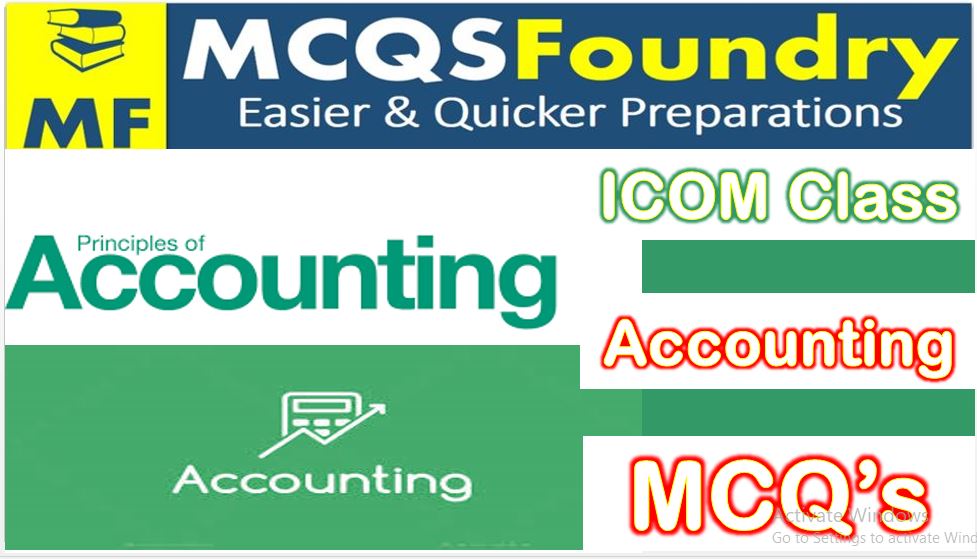MCQsFoundry.com brings to you 500+ Financial Accounting ICOM Mcqs which are new and latest. These Mcqs are never published on internet so far. For full information about all PPSC / FPSC / CSS / PMS latest jobs visit theiteducation.com

Chapter #11
Adjustments and Their Effect on Final Account
Encircle the most appropriate answer from the following :
1. The system of accounting in which accounting entries are made only when cash received or paid is known as:
- Cash system
- Mercantile system
- Accrual system
- Single system
2. All those expenses which have become due but not paid are called:
- Accrued revenue
- Prepaid revenue
- Outstanding expenses
- Advance expenses
3.The accounting system in which accounting entries are made on the basis of amount having become due for payment or receipt, is called
- Cash system
- Outstanding system
- Accrual or mercantile system
- None of these
4. All those expenses which have not become due but paid in advance are called:
- Outstanding expenses
- Accrued expenses
- Payable expenses
- Prepaid expenses
5. An income which has earned but not received is called:
- Unearned income
- Revenue received in advance
- Accrued revenue
- None of these
6. A prepaid expense is:
- An Asset
- A liability
- An Expense
- An Income
7. The revenue that has not become due, but received in cash in current year is known as:
- Revenue received in advance
- Unearned revenue
- Accrued revenue
- Both 1 and 2
8. The accrued income or outstanding income will appear in balance sheet as:
- An expense
- A liability
- An asset
- Both a and b
9. Outstanding expense given in adjustment is called:
- An asset
- An expense
- A gain
- A liability
10. A gradual decrease in the value of fixed assets is called:
- Reduction
- Deprecation
- Revaluation
- None of these
11. Deprecation is:
- A Liability
- An Expense
- A Loss
- Both 2&3
12. From business point of view, Interest on capital is considered as:
- An income
- An expense
- A profit
- A liability
13. Interest due but not received is an
- Outstanding expense
- Unearned income
- Prepaid expense
- Accrued income
14. Interest on drawings is:
- An asset
- A liability
- An expense
- A Revenue
15. Net profit is always:
- Equal to gross profit
- More than gross profit
- Less than gross profit
- None of these
16. Wages paid for installing a machine should be debited to:
- Wages ale
- Machinery a/c
- Cash alc
- None of these
17. Net loss is always:
- Equal to gross loss
- More than gross loss
- Less than gross loss
- None of these
18. Income tax paid is a:
- Business expense
- Revenue for business
- Liability of business
- Personal expense
19. Patent is an example of:
- Assets
- Liabilities
- Income
- Expense
20. The amount becomes due from the customers is called:
- Allowance
- Debts
- Loan
- Doubtful debts
21. The debts, which are irrecoverable from the debtors, are called:
- Debts
- Good debts
- Doubtful debts
- Bad debts
22. Bad debts are business:
- Expenses
- Assets
- Liabilities
- Revenue
23. Bad debts recovered from debtors should be credited to:
- Debtors a/c
- Bad debts recovered a/c
- Bad debts a/c
- Cash a/c
24. The debts, the recovery or realization of which is uncertain are known as:
- Bad debts
- Provision for doubtful debts
- Doubtful debts
- Loan
25. Provision for the doubtful debts is debited to:
- Debtors alc
- Profit or loss a/c
- Provisions for bad debts a/c
- Bad debts recovered alc
26. Business allow cash discount on making prompt payment to its:
- Creditors
- Partners
- Debtors
- Investors
27. Business receive discount from its:
- Creditors
- Partners
- Debtors
- Owners
28. Withdrawal of goods by the owner for his personal use must be credited to:
- Drawings a/e
- Purchasers a/c
- Goods a/e
- Capital ac
29. If the closing stock appears in the trial balance it is taken only to the:
- Profit & loss account
- Trading account
- Balance sheet
- Final Account
30. The loss on the sale of old machinery is debited to:
- Machinery a/c
- Depreciation a/e
- Accumulated depreciation
- Profit & loss Account
31. Adjusting entries are made:
- During the accounting period
- At the end of accounting year
- In the beginning of the year
- At any time
32. Provisions for bad debts should appear in the balance sheet as:
- A fictitious asset
- A deduction from the debtors
- Part of the share capital
- An addition to the good will
33. Bad debts are debited to:
- Debtor’s a/e
- Provisions for bad debts a/e
- Creditors a/c
- Bad debts a/c
34. In the balance sheet pre-received income is shown on:
- Assets side
- Both assets & liabilities sides
- Liabilities side
- None of these
35. Provision for discount on creditors must be credited to:
- Creditors a/c
- Provisions for discount on creditors a/e
- Profit and loss a/c
- Cash a/c